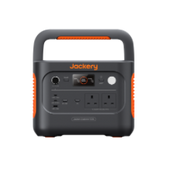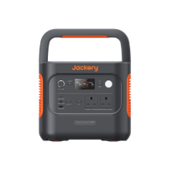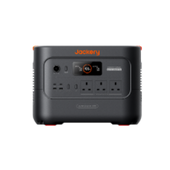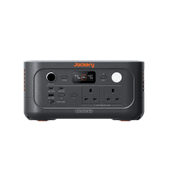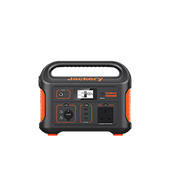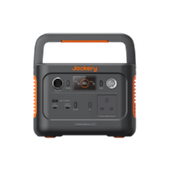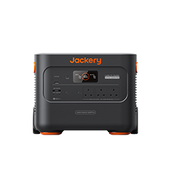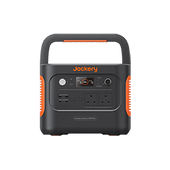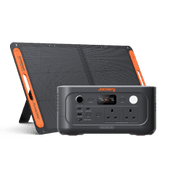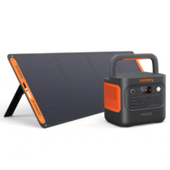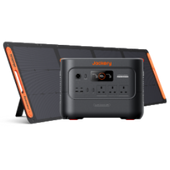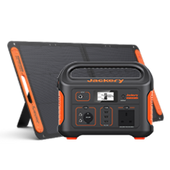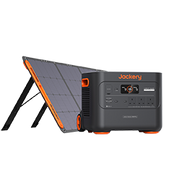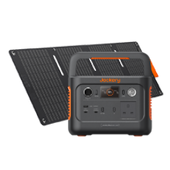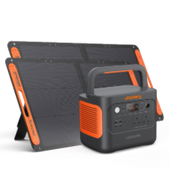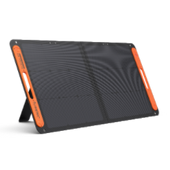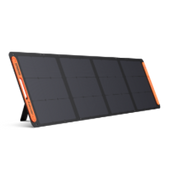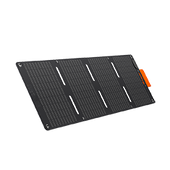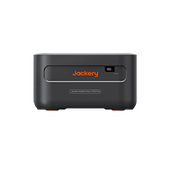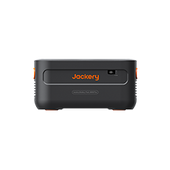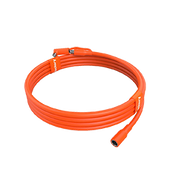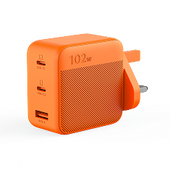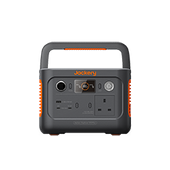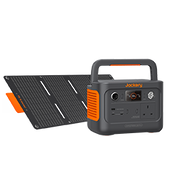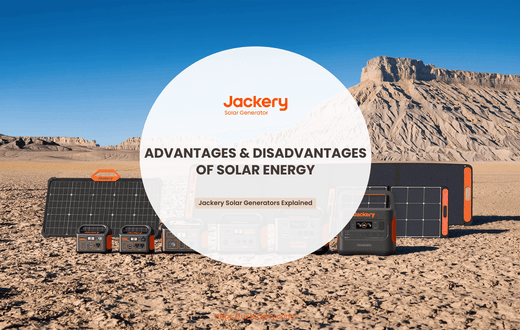There is no doubt that solar energy is a powerful energy source. Therefore, the pros and cons of solar energy are a hot topic today. As an abundant energy source, solar energy offers great hope to the world as a clean and reliable energy source.
Although solar energy has many advantages, its disadvantages cannot be ignored. This guide introduces the basics of solar energy and details its advantages, disadvantages, and application areas.
A solar generator, like Jackery Solar Generator, is a good choice if you want to try solar energy but have a limited budget. It combines solar panels with a portable power station to effectively turn sunlight into electricity.
|
Key Takeaways: |
|
- Solar energy mainly comprises visible, infrared, and ultraviolet rays. It comes from the nuclear fusion reaction in the sun's core. - The working principle of solar energy is summarised as the photovoltaic effect, which converts sunlight into electrical energy. - Its rich energy reserves and environmentally friendly characteristics show great potential in many fields. - We recommend Jackery Solar Generator 1000 Plus and 1000 v2, portable solar systems for charging appliances and electronics indoors and outdoors. |
What Is Solar Energy?
With the continuous advancement of technology, solar energy, a clean energy source, has again become the focus of attention. From home water heaters to large-scale photovoltaic power generation systems, solar energy's application range is becoming increasingly broad, and its popularity is also increasing. However, many people still wonder what solar energy is.
Solar energy is mainly composed of visible, infrared, and ultraviolet rays. It comes from the nuclear fusion reaction in the sun's core. Solar energy maintains life on Earth and has gradually become essential for humans to solve energy problems.
In short, as technology advances and costs are reduced, solar energy will become increasingly significant in the future energy structure.
How Does Solar Energy Work?
The working principle of solar energy is summarised as the photovoltaic effect, which converts sunlight into electrical energy. The entire process relies on solar panels. In simple terms, solar energy is generated by photovoltaic panels installed on homes, buildings, and solar farms worldwide.
Solar panels are key parts of solar power generation systems. They are usually composed of multiple solar cells, which are mainly made of semiconductor materials such as silicon.
Step 1: Photovoltaic Effect
When sunlight shines on these panels, photons or light particles hit the thin silicon layer on the panel's top. If electrodes are added to both sides of the silicon wafer and connected to a circuit, an electric current is generated. Solar panels can convert sunlight energy directly into electrical energy.
Step 2: Power Inversion
Usually, the current generated by solar panels cannot be used directly by households or public power grids, and a solar inverter is required to invert the current.
Step 3: Power Storage
In a solar system, if the power generated exceeds the home's current power demand, the excess power will flow to the grid through the meter. Alternatively, the excess power will be stored in batteries to ensure a power supply at night or when there is insufficient light.

In short, solar energy converts sunlight into electrical energy through the photoelectric effect. After conversion, the inverter and support of the energy storage system provide humans with a clean and renewable energy solution.
The Advantages of Solar Energy
In recent years, solar energy has received widespread attention and application worldwide as an inexhaustible and clean energy source. The following are several significant advantages of solar energy as an energy source.
Universality and Sustainability
Solar energy is everywhere, whether on land, sea, mountains, or islands. Thus, solar energy can be directly developed and utilised in any area without complex mining and transportation processes.
In addition, compared with fossil fuels, solar energy will not be depleted and will not produce greenhouse gas emissions, thus having a positive impact on global climate change.
Environmental Protection and Cleanliness
Solar energy does not produce polluted gas or cause air, noise, or solid waste pollution during development and use. Therefore, it becomes an excellent alternative to fossil fuels and helps reduce environmental pollution and global climate change.
Save Energy Costs
Although the initial investment in installing a solar system is high for households and businesses, solar systems can significantly reduce utility costs in the long run. As technology advances and costs fall, the initial investment gradually becomes more attractive, often paying for itself within a few years.
Energy Independence
Solar energy can alleviate environmental problems and resource shortages caused by fossil fuel consumption. Therefore, solar power generation can improve energy security and avoid supply interruptions caused by external factors such as grid failures and storms. Solar power systems can operate independently, allowing homes and businesses to be self-sufficient during power outages and ensuring the regular operation of critical equipment and systems.
Wide Range of Applications
Solar energy has various uses, not only for generating electricity but also for heating water, heating, refrigeration and other fields. Solar energy can also be incorporated into building materials. In addition, solar power supply systems are also widely used in many fields, such as homes, commerce, agriculture, transportation, and outdoor adventures, demonstrating their diverse application potential.
Low Maintenance Cost
Solar systems are relatively low-maintenance compared to other power generation technologies. Solar panels only need to be cleaned twice a year after installation, and the inverter needs to be replaced regularly to ensure they operate effectively. Therefore, after covering the initial cost of a solar system, you will have to spend very little money on maintenance and repair work.

The Disadvantages of Solar Energy
Although solar energy has many advantages, completely ignoring some potential disadvantages would be a mistake. When considering switching to solar energy, weighing the pros and cons is essential. Here are some disadvantages of solar energy:
High Initial Cost
Although solar power generation systems' operation and maintenance costs are low, their initial investment is relatively high. The purchase and installation costs of hardware equipment such as photovoltaic panels, energy storage equipment, and inverters are expensive, which makes the investment payback period of solar energy projects longer. Therefore, the initial cost of solar energy has limited its popularity and application to a certain extent.
Intermittent and Unstable
Solar power generation is unstable and affected by day and night, seasons, and weather. Solar energy systems usually generate electricity during the day but cannot work at night. Excess unused energy can only be stored by installing battery packs at night and during storms.
Regional Dependence
The distribution of solar energy resources has noticeable regional differences. Factors such as geographical location and sunshine time affect solar energy utilisation efficiency. For example, solar power generation is better in areas with many solar energy resources, such as deserts and tropical regions.
Space Requirements
Installing enough solar panels to meet electricity needs requires a lot of space, which is challenging in dense urban areas or areas with limited land resources. When solar panels cannot be installed on rooftops, they occupy more land space. In addition, installing solar panels may affect the aesthetics of the building, especially in historical buildings or cultural heritage protection areas.
Initial Pollution During the Manufacturing Process
Although solar energy is cleaner than many alternative sources, its production and installation involve emissions and hazardous substances. The manufacturing process generates pollutants, so the disposal of solar panels must be carefully managed to avoid environmental harm.
Grid Compatibility Issues
Large-scale grid-connected solar systems will affect the stability of the power grid. Due to solar power generation's intermittent and unstable nature, the power grid must have sufficient regulation capacity to absorb and distribute these fluctuating power sources. Otherwise, grid-connected solar systems may damage the power grid and affect its safe operation.
Where Is Solar Energy Applied?
Today, solar energy has received widespread attention and application around the world. Its rich energy reserves and environmentally friendly characteristics show great potential in many fields. The following are several aspects of the main application of solar energy:
Solar Power Generation
Solar power generation mainly converts sunlight directly into electrical energy through solar panels. It is widely used in homes, businesses, and public facilities. For example, rooftop solar panel systems can provide electricity for homes and reduce electricity bills. Solar generators are another portable solar system that can conveniently use solar energy.
The key benefits of a solar generator, like Jackery Solar Generator, encompass clean and renewable energy production without emissions, low operating costs thanks to free sunlight, quiet functionality, portability, minimal maintenance requirements, and independence from the grid during power outages. This positions it as a sustainable and environmentally friendly power source in contrast to traditional fuel-powered generators.

Communication
Applying solar cells in facilities such as communication base stations ensures the regular operation of these devices in remote areas and areas with unstable power grids. For example, many communication base stations in mountainous and desert areas rely on solar cells for power supply, ensuring unimpeded communication.
Transportation Field
Solar energy also plays a significant role in transportation. Solar street lights, signals, and beacon lights use solar panels to provide electricity, reducing the burden on urban power grids. In addition, the development of solar cars and electric vehicles also demonstrates the broad prospects of solar technology in the transportation field.
Agricultural Irrigation
Solar panels can power irrigation systems in the agricultural field. Farmers can easily transport water to farmland through solar water pumps and achieve water-saving irrigation. Solar irrigation systems can solve the problem of insufficient power supply, especially in remote areas.
Environmental Governance
Solar energy, such as seawater desalination, can also be used for environmental governance. Through solar thermal distillation technology, seawater can be converted into fresh water to solve the drinking water problem in some areas.
Aerospace Field
In aerospace, solar panels are widely used in satellites and space stations to provide the required power. Solar panels can continuously convert solar energy into electrical energy to ensure the regular operation of spacecraft.
Jackery Solar Generators Explained
Jackery Solar Generators combine Jackery Solar Panels with Portable Power Stations to transfer sunlight into electricity. They offer rapid solar charging, charging power stations in just a few hours. The Jackery Solar Panels utilise monocrystalline silicon solar cells and boast an impressive efficiency rate of 25% to facilitate swift charging. Additionally, power stations can be recharged using car chargers or wall outlets for extra convenience.
Jackery Portable Power Stations feature an advanced BMS (Battery Management System) designed to safeguard the devices against short circuits, under and overvoltage, and extreme temperatures. Featuring enhanced ChargeShield technology, they offer three charging modes: fast charging, whisper-quiet charging, and emergency supercharging to ensure you stay powered at all times and places.
With a solar generator for home backup or off-grid living, you can keep your WiFi running, your refrigerator running to prevent food from going bad, and your CPAP charging for a restful night's sleep. These devices are made to survive for more than ten years, even if you use them every day.
|
Appliances |
Working Hours |
|
|
Jackery Solar Generator 1000 v2 (1070Wh) |
Jackery Solar Generator 1000 Plus (1.25-5 kWh) |
|
|
Refrigerator (700W) |
1.2H |
1.53-6.1H |
|
Computer (200W) |
4.3H |
5.4-21.25H |
|
Phone (10W) |
85.6H |
107.1-425H |
|
Lighting (50W) |
17.1H |
21.42-85H |
|
Portable Heater (1000W) |
0.9H |
1.1-4.25H |
Jackery Solar Generator 1000 v2
Firstly, we introduce Jackery Solar Generator 1000 v2, an Explorer 1000 v2 portable power station combo with SolarSaga 100W or 200W solar panels. We will introduce each component in detail.

Explorer v2 Capacity & Charging Ability: The Explorer 1000 v2 Portable Power Station provides an impressive 1500W output, 50% greater than earlier models. It efficiently supplies power to high-demand devices such as refrigerators, kettles, and portable heaters. Equipped with USB-A/C connections and dual PD charging up to 100W, it can simultaneously charge several devices (phone, laptop), rendering it the ideal companion for all your power requirements.
Fast Recharging Capability: The Emergency Charge Mode, activated via the app, enables the Explorer 1000 v2 Portable Power Station to achieve a full charge in under one hour, providing essential power backup when the battery is depleted. Moreover, charging from 0% to 100% within two hours via an AC wall outlet prolongs battery longevity.
Quiet Operation: Experience peace with its nearly silent operation, maintaining noise levels below 22dB while charging your devices. Compared to other traditional generators, this one is more suitable for home use and has sufficient power capacity.
High-Conversion Solar Panels: Achieve reduced weight and enhanced performance with a cutting-edge solar system. The 100W bifacial high-efficiency solar panel, featuring a conversion rate of up to 25%, integrates advanced IBC technology with a sleek black design, enhancing power generation while minimising weight.
|
*Review from Our User |
|
First, this item is robust and space-efficient, fitting seamlessly in my workspace (see pic). When the power goes out, it becomes a real game changer. I can continue my tasks as if everything is normal, which is impressive. The most advantageous aspect for me? The USB-C ports. I can connect my Mac directly to it without needing an adapter. Incredibly useful! |
Jackery Solar Generator 1000 Plus
Jackery Solar Generator 1000 Plus is more powerful and versatile than 1000 v2. It is a solid portable solar energy solution that pairs Explorer 1000 Plus with SolarSaga 100W solar panels and delivers outstanding performance. With its impressive capacity and powerful output, this device can support the operation of essential appliances for a few days, especially during power outages or off-grid living.

Expandable Capacity for Indoor & Outdoor Uses: The Jackery Solar Generator 1000 Plus enables the addition of extra battery packs, increasing the capacity from 1260Wh to an impressive 5 kWh, thereby significantly satisfying your power needs. This solar product has a remarkable output of 2000W, supporting most appliances indoors or outdoors.
Multiple Fast Refueling Methods: The MPPT technology guarantees 99% solar charging efficiency. It requires 100 minutes for a wall charge (from 0% to 100% battery) and two hours for solar charging with four SolarSaga 200W solar panels. Thanks to automobile charging compatibility, you won't have to worry about power outages anymore!
Safety First: Jackery's industry-leading ChargeShield fast charge technology uses a stepped variable-speed charging algorithm to increase battery pack longevity by 50% and improve safety. The power station can be fully charged in about 5.5 hours, even at a high temperature of 45°C.
Longer Lifespan: The LiFePO4 battery system is robust and safe, with a self-developed BMS (Battery Management System) with integrated safeguards. Even with daily charging, the battery level stays at 70% after 4,000 charge cycles, guaranteeing a 10-year longevity. As a result, the cycle life is eight times longer than that of competitors.
|
*Review from Our User |
|
Everything was packaged and handled with care, and the delivery was quick. I needed a well-constructed Portable Power Station to do more than charge a smartphone. Could it power a coffee pot or a toaster? I connected an Echo Show 8, a laptop, and a 43" HDTV without issues. The User Manual is easy to understand and well-illustrated, providing clear explanations on calculating wattage. |
The Solar Energy in the UK
As of early 2024, the UK boasts a total installed solar capacity of approximately 15.7 gigawatts (GW), reflecting a notable rise in recent years. This capacity is mainly derived from solar photovoltaic (PV) panels. The nation is committed to substantially enhancing its solar power generation to achieve net zero targets by 2050, which may necessitate an increase to as much as 90 GW of solar capacity.
Solar power plays a modest yet expanding part in electricity generation in the United Kingdom.
Until 2010, there were limited installations, but that changed when the UK government introduced subsidies through a feed-in tariff (FIT), funded by all electricity consumers. In the subsequent years, the price of photovoltaic (PV) panels decreased, and the feed-in tariff (FIT) rates for new installations were gradually lowered until the program ceased accepting new applications in 2019.
By 2023, more than 14.4 gigawatts (GW) had been installed, with one-third of that total coming from rooftop solar. In 2022, annual generation reached 14 TWh, accounting for 4.3% of the UK's electricity consumption, with peak generation exceeding 11 GW. In the UK climate, PV panels exhibit a capacity factor of approximately 10%. Home rooftop solar panels installed in 2022 were projected to recoup their investment within ten to twenty years.
|
Year |
Capacity (MW) |
Generation (GW.h) |
Effective Capacity Factor |
%of Total Electricity Consumption |
|
2016 |
11,562 |
10,395 |
0.102 |
3.1 |
|
2017 |
12,690 |
11,457 |
0.103 |
3.4 |
|
2018 |
12,992 |
12,736 |
0.111 |
3.8 |
|
2019 |
13,265 |
12,418 |
0.111 |
3.8 |
|
2020 |
13,579 |
12,903 |
0.108 |
4.1 |
|
2021 |
13,965 |
12,138 |
0.099 |
3.9 |
|
2022 |
14,660 |
13,921 |
0.108 |
4.3 |
|
2023 |
15.993 |
13.826 |
0.103 |
4.8 |
(Data Source: Wikipedia)
The annual insolation in the UK ranges from 750 to 1,100 kilowatt-hours per square metre (kWh/m2). In December, London receives 0.52 kWh/m2 per day, while in July, it receives 4.74 kWh/m2 per day.
Although the sunniest regions of the UK receive significantly less solar radiation than the sunniest areas in Europe, the insolation levels in the southern parts of the country are similar to those found in central European nations, such as Germany, which produces approximately 10.7% of its electricity from solar energy.
Furthermore, the elevated wind speeds in the UK contribute to cooling PV modules, resulting in efficiencies that surpass expectations given the insolation levels. The capacity factors of solar PV in the UK ranged from 9.8% to 11.4% from 2013 to 2022.
FAQs
The following are the frequently asked questions about the advantages and disadvantages of solar energy:
1. What are renewable resources?
Renewable resources refer to energy that can be continuously and sustainably used in nature. They have little environmental impact, are widely distributed, and are suitable for local development. Types of renewable resources include:
Solar energy
Wind energy
Hydropower
Geothermal energy
Ocean energy
Biomass energy
2. What are the most common reasons people choose solar energy?
Solar energy has the following advantages:
Universality and sustainability
Environmental protection and cleanliness
Energy cost savings
Energy independence
Wide application
Low maintenance cost
3. What is the most significant disadvantage of solar energy?
Solar energy currently faces the following challenges:
High initial cost
Intermittency and instability
Regional dependence
Space requirements
Initial pollution during the manufacturing process
Grid compatibility issues
Solar energy's most apparent challenges are its intermittency and instability.
Intermittency means that solar energy generation is limited by natural conditions, especially the alternation of day and night and weather changes.
Solar radiation wildly fluctuates due to various factors (latitude, altitude, season, etc.), reflecting instability.
4. Is solar energy worth it in the UK?
In the UK, choosing solar energy is worth considering. It is environmentally friendly and saves consumers money, making it a worthwhile investment. In recent years, solar energy in residential, commercial, and large-scale projects has experienced steady, unsubsidised growth, indicating that the development of the UK solar energy market has finally matured.
In summary, choosing solar energy in the UK has obvious environmental and economic benefits and is a recommended energy solution.
Final Thoughts
As technology develops and awareness of environmental impacts grows among households nationwide, solar energy becomes a viable alternative to traditional energy sources. But when considering home energy options, it's essential to understand how solar energy works. In addition, to enable you to make an informed choice about whether solar energy is right for you, we've outlined some of its advantages and disadvantages.



